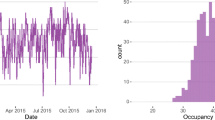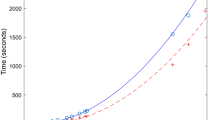Abstract
There is considerable evidence that the distribution of the length of time that a patient occupies a bed in a hospital department is best described by a sum of two or three exponential terms, because of the presence of acute care, rehabilitation, and possibly long term care patients in the department. The patient flow models implied by these mixed exponential distributions are presented and fitting them to observed data when the admission rate fluctuates is discussed. Unlike single exponential distributions, mixed exponential distributions imply that the average length of stay of patients currently resident in the department is much longer than the average length of stay of a group of patients discharged over a period of time, so that the latter way of measuring will not correctly indicate what portion of the resources are being used by rehabilitation and long term care patients. Also, the expected additional length of stay increases dramatically with the time already spent in the department. Applications to predicting the effects of policy changes and to long term monitoring of hospital departments are presented. Two American hospitals are analyzed. The occupancy times in the government supported hospital follow a mixed exponential distribution similar to those found in the United Kingdom, but in the private hospital they fit a single exponential distribution, indicating markedly different management practices.
Similar content being viewed by others
References
P.H. Millard, Geriatric medicine: a new method of measuring bed usage and a theory for planning, MD thesis, University of London (1989).
P.H. Millard et al., Occupancy plotting: a method of estimating bed usage in departments of geriatric medicine, Division of Geriatric Medicine, St. George's Hospital Medical School, London (1989).
G.W. Harrison and P.H. Millard, Balancing acute and long term care: the mathematics of throughput in departments of geriatric medicine, Methods of Information in Medicine 30 (1991) 221–228.
A. Abidi and P.H. Millard, Database analysis of a midnight bed return, in: La sociedada ante el envejecimiento y la minusvalia, eds. J.M. Via and E. Portella, Vol. 2 (SYSTED 91, 1994) pp. 637–640.
P.H. Millard and S.I. McClean, eds., Part three: Applications of occupancy modelling, in: Modelling Hospital Resource Use: A Different Approach to the Planning and Control of Health Care Systems (Royal Society of Medicine, London, 1994) pp. 63–111.
S.I. McClean and P.H. Millard, A decision support system for bedoccupancy management and planning in hospitals, IMA Journal of Mathematics Applied in Medicine and Biology 12 (1995) 225–234.
G.W. Harrison, Compartmental models of hospital patient occupancy patterns, in: Modelling Hospital Resource Use: A Different Approach to the Planning and Control of Health Care Systems, eds. P.H. Millard and S.I. McClean (Royal Society of Medicine, London, 1994) pp. 53–61.
S.I. McClean and P.H. Millard, A three compartment model of the patient flows in a geriatric department: a decision support approach, Health Care Management Science 1 (1998) 159–163.
V. Irvine, S.I. McClean and P.H. Millard, Stochastic models for geriatric in-patient behavior, IMA Journal of Mathematics Applied in Medicine and Biology 11 (1994) 207–216.
G. Taylor, S.I. McClean and P.H. Millard, Geriatric-patient flow-rate modelling, IMA Journal of Mathematics Applied in Medicine and Biology 13 (1996) 297–307.
G. Taylor, S.I. McClean and P.H. Millard, Using a continuous-time Markov model with Poisson arrivals to describe the movement of geriatric patients, Applied Stochastic Models and Data Analysis 14 (1998) 165–174.
W.H. Press et al., Numerical Recipes, The Art of Scientific Computing (Cambridge University Press, Cambridge, 1986).
S. Zacks, Introduction to Reliability Analysis (Springer-Verlag, New York, 1992).
E.J. Dickinson, The ABC (appropriateness of bed-use census) project, in: Modelling Hospital Resource Use: A Different Approach to the Planning and Control of Health Care Systems, eds. P.H. Millard and S.I. McClean (Royal Society of Medicine, London, 1994).
S.I. McClean and P.H. Millard, Modelling in-patient bed usage behaviour in a department of geriatric medicine, Methods of Information in Medicine 32 (1993) 79–81.
M. Gonsalkorale, An IT approach to planning geriatric and general medical services, in: Go with the Flow, A Systems Approach to Healthcare Planning, eds. P.H. Millard and S.I. McClean (Royal Society of Medicine, London, 1996) pp. 111–119.
Y. Stone, The measurement and planning of services in Riverside Hospital, in: Go with the Flow, A Systems Approach to Healthcare Planning, eds. P.H. Millard and S.I. McClean (Royal Society of Medicine, London, 1996) pp. 121–126.
Author information
Authors and Affiliations
Rights and permissions
About this article
Cite this article
Harrison, G.W. Implications of mixed exponential occupancy distributions and patient flow models for health care planning. Health Care Management Science 4, 37–45 (2001). https://doi.org/10.1023/A:1009601732387
Issue Date:
DOI: https://doi.org/10.1023/A:1009601732387




